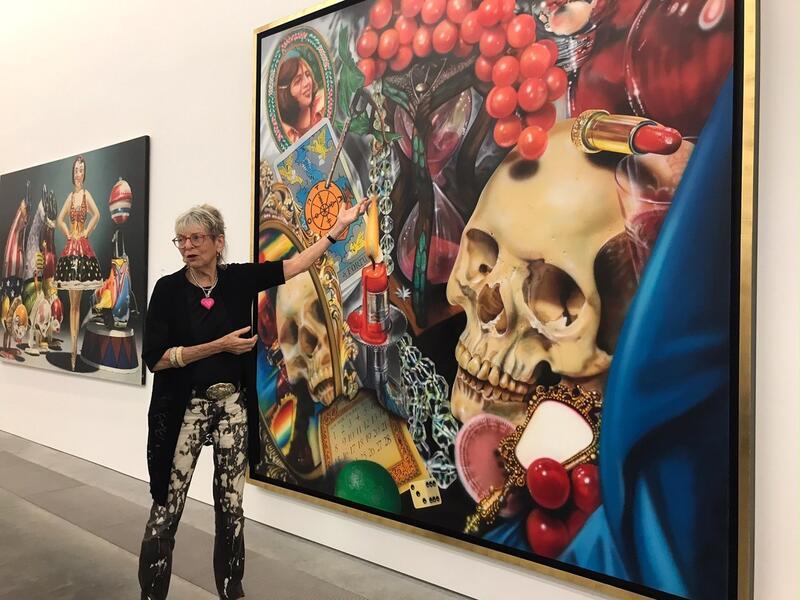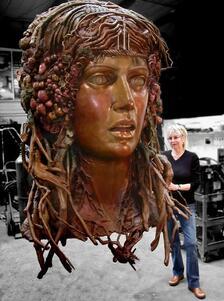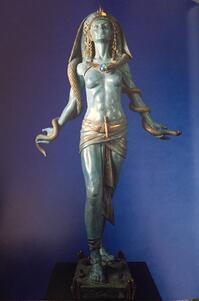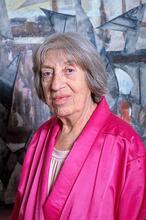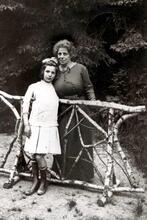Audrey Flack
Painter and sculptor Audrey Flack, especially recognized for the feminine content in her art, trained at Yale. Through the early 1950s she made canvases in a gestural, abstract expressionist style. Unsatisfied, she resolved to paint in a representational fashion. Flack was the only female member of the founding group of photorealists. Unlike most male photorealists, who coolly paint neutral content derived from photographs, Flack’s illusionist canvases plumb personal, socio-political, and feminist issues replete with complex symbolic iconography. In the 1980s, Flack turned to sculpture, which frequently depicts goddesses and other strong female figures. She received several major commissions resulting in large-scale public sculpture, such as Civitas, a gateway to Rock Hill, South Carolina, consisting of four 20-foot tall bronze statues of women holding symbols of the city.
The only female member of the founding group of photorealists, American painter and sculptor Audrey Flack is widely recognized for the feminine content in her art. Her feminist sensibilities manifest in both her pioneering paintings, which often consider stereotypes of womanhood, and her sculptures, frequently depicting goddesses and other strong female figures.
Education & Early Career
Born in New York to Jeanette and Morris Flack, Eastern European immigrants from Galicia, Audrey Flack was five years younger than her brother Milton. Her Jewish identity was nurtured by her middle-class parents who, although not orthodox in their religiosity, lit candles for the Sabbath and observed Passover and the High Holy Days.
As a child, Flack knew that she wanted to be an artist; among her early work is a watercolor of rabbis in a synagogue, painted when she was around fourteen years old. She studied at the High School of Music and Art and Cooper Union (1948–1951), later receiving her B.F.A. from Yale University (1952), where she trained with modernist Josef Albers. Through the early 1950s Flack painted canvases in a gestural style influenced by Abstract Expressionism, as exhibited at a solo exhibition at the Roko Gallery (1959) in New York. Unsatisfied, Flack resolved to paint in a representational fashion even though at the time many viewed the mode as passé. Additional studies at the Art Students League confirmed her desire to paint representationally. When Flack returned to figuration she took yet another chance by choosing to explore her own identity through self–portraits and portraits of her young daughters, Melissa (b. 1959) and Hannah (b. 1961). Her musician husband was uninvolved with the children and at times threatening, but Flack believed that she could do it all: caring for her daughters would not stop her from having a successful artistic career. Flack’s ambitions were further compounded by Melissa’s severe autism; while highly intelligent, Melissa is mute and to this day still requires around-the-clock supervision. By 1968, Flack was divorced and two years later she married her high school sweetheart, Bob Marcus, who adopted both girls.
During the 1960s Flack began to utilize photographs as the inspiration for her imagery. Initially she favored black-and-white news photographs as source material, featuring public figures such as John D. Rockefeller (1963) and even Adolf Hitler (1963–64) in subdued colors. A canvas portraying President Kennedy (1964) in his motorcade moments before his assassination was her first painting in this vein from a media–generated color photograph.
Early Still-lifes
In the early 1970s, negotiating single motherhood while pursuing her art, Flack started the large–scale canvases for which she is best recognized. Based on configurations of objects arranged by Flack in her studio and then photographed, Jolie Madame (1972), her first monumental photorealist still-life, was executed with both underpainting and airbrush from a slide projected on a wall. Now part of the permanent collection of the National Gallery of Australia, Jolie Madame embraces and celebrates traditional objects associated with femininity and feminine beauty, including glistening jewelry and the perfume bottle that lends the painting its title. Soon after its completion, the detailed canvas appeared in “Women Choose Women” at the New York Cultural Center, the first large-scale exhibition organized by women and solely showing art by women. The Museum of Modern Art purchased Leonardo’s Lady (1974), from Flack’s Grey Border series, within a year of its completion; it was the first photorealist painting the museum acquired.
Vanitas series
Comprised of three paintings all eight feet square, Flack’s early Vanitas series (1976–78) drew inspiration from Baroque still-life allegories that comment on the transience of life. Painted with lush, intense colors and a high gloss surface, Marilyn (Vanitas) (1977), the best known of the series, explores stereotypes of womanhood. Amid matter of decided feminine content, such as the perfume bottles, makeup, and jewelry that defined her subject, Flack depicts a young, as-yet-uncorrupted Norma Jean in a black-and-white photograph before she became the brittle, blond Marilyn Monroe of Hollywood. Flack aimed to comment on the sex symbol’s ephemerality by presenting these objects and the woman along with a burning candle, a shifting hourglass, and a shriveling orange. At the same time, the flawless painting also evokes the artist’s own vulnerability, as Flack includes a self-portrait based on a photograph of herself as a young girl. This painting and so many others demonstrate how Flack’s concerns differed from her male counterparts, something that was noticed, sometimes unfavorably, by the press. Flack did not want to coolly paint neutral content derived from photographs, typical of her male peers, and instead proudly produced illusionistic canvases plumbing personal, socio–political, and feminist issues replete with complex symbolic iconography.
Audrey Flack, World War II (Vanitas), 1976-77. Oil over acrylic on canvas, 96 x 96 in. Pennsylvania Academy of the Fine Arts, Philadelphia World War II (Vanitas) by Audrey Flack, incorporating a portion of the photograph “Buchenwald, April 1945" by Margaret Bourke-White, © Time Inc. Photo courtesy Audrey Flack. Art © Audrey Flack.
Another excellent example of Flack’s highly individual approach is the lesser-known and exceptionally powerful and personal first Vanitas painting, World War II (Vanitas) (1976–77). Also anchored by a magnified, sharply delineated trompe l'oeil (trick of the eye) color still–life and black-and-white photograph, this canvas combines pretty objects with a reproduction of Life photographer Margaret Bourke-White’s iconic, devastating picture of the liberation of Buchenwald (1945). Rendered in black-and-white, the exhausted and stunned prisoners behind the barbed wire fence contrast with the rich, glowing colors of the pastries sitting on a heavily polished silver platter. Among the array of other objects in front of Bourke-White’s duplicated photograph are a red candle dripping like blood, a rose, and a Star of David from Flack’s keychain. Some of these objects sit on a book open to a quote about faith from the Hasidic leader Nahman of Bratslav (1772–1810). Flack explained why she amalgamated such diverse elements: “My idea was to tell a story, an allegory of war…of life….the ultimate breakdown of humanity…the Nazis…to create a work of violent contrasts, of good and evil. Could there be a more violent contrast than that?” (exact transcription from original; Audrey Flack on Painting, 78).
Sculptures and Public Commissions
In the early 1980s, believing that she had exhausted the possibilities of photorealism, Flack started making large indoor and outdoor bronze sculptures, some on commission, of female goddesses such as Diana, Medusa, and Athena, as well as invented deities. Sculpted after posed models in her studio, Flack offers these women as strong heroines rather than as objectified figures. Egyptian Rocket Goddess (1990), a semi-nude bronze with a taught body, stands forty-two inches high on her base. Striding forward, the goddess’s arms are wrapped by snakes meant to recall ancient Minoan snake goddesses whose reptiles symbolized fertility. Coalescing the modern with the ancient, a rocket appears on the drapery around the goddess’s waist and on her headdress.
Flack received several major public commissions resulting in public sculpture. Civitas (1991), a monumental gateway to the city of Rock Hill, South Carolina, consists of four 20-foot tall bronze statues of women holding symbols of the city. A fourteen-foot tall bronze Recording Angel, sculpted for the Schermerhorn Symphony Center in Nashville (2006), portrays a classically dressed angel who holds a feathered quill in her left hand and a compact disc in her right hand, as if inscribing musical notes.
Biblical and Jewish Themes
Along with World War II (Vanitas), Flack has made a number of other works related to her religio-cultural heritage. When Flack returned to figuration she painted Matzah Meal Still Life (c. 1960), which shows the ingredients needed to make foods typically eaten on Jewish holidays. Carefully arranged on the delightful, Pop–influenced canvas are products by Manischewitz, the best-known kosher food provider, in addition to other kosher ingredients found in a Jewish home. She produced a portrait of Anwar Sadat for the cover of Time magazine’s January 2, 1978, issue on the leader as “man of the year.” Her composition presents Sadat in three-quarter’s view against a brightly colored background. The background incorporated subtle symbolism: The blue and white sky represents Israel and the Israeli flag with the colors below indicating the Egyptian flag.
Flack has also tackled biblical subjects, from both the Hebrew and the Christian Bible, in watercolor, oil, and sculpture. For six years Flack worked on a 36-inch tall statue of Eve (2006–12), who holds interest for the artist because of her role as the first mother but also because, as Flack put it: “I’m trying to restore Eve’s image like I’m trying to restore women’s image. My Eve is sexual and beautiful. I want Eve to be accepted as intelligent. She can have a baby and she can pick from the Tree of Knowledge and still stand tall. She wants answers. That’s a good thing” (Flack, interview with the author, New York, June 18, 2010).
Music and Recent Work
Around 2005, Flack began attending banjo camp and has since become an accomplished banjo player. She quickly learned to frail and claw hammer and subsequently formed a band, appropriately named “Audrey Flack and the History of Art Band.” The band’s repertoire comprises songs written by Flack about art-related subjects and a wide range of artists, among them Mary Cassatt, Jackson Pollock, and Lee Krasner, set to old-time bluegrass melodies. A CD was released in 2013.
Flack recently and ardently turned to drawing. She is exploring two of her enduring interests: women and religion. Drawing has also led her back to painting, this time with a brush to canvas rather than using an airbrush.
Books, Honors, and Awards
From 1992–93, a major retrospective of Flack’s art, organized by the J.B. Speed Art Museum in Louisville, Kentucky, traveled to four museums around the country, including the National Museum of Women in the Arts. Among many awards and honors, Flack holds an honorary doctorate from Clarke University and received the Augustus Saint-Gaudens Medal from Cooper Union. She has written three books, Audrey Flack on Painting (1986), Audrey Flack: The Daily Muse (1989), and Art and Soul: Notes on Creating (1991). Flack is the first living female artist to appear in H.W. Janson’s revised textbook—the standard in the field for decades. In 2017, Flack received a lifetime achievement award from the Women’s Caucus for Art. An award-winning 75-minute documentary film about her art and life, Audrey Flack: Queen of Hearts, was released in 2019. Flack’s art is held by prominent museums across the world.
Selected Writing by Audrey Flack
Flack, Audrey. Audrey Flack on Painting. Introduction by Lawrence Alloway. New York: Harry N. Abrams, Inc., Publishers, 1981.
Flack, Audrey. Art and Soul: Notes on Creating. New York: E. P. Dutton, 1986.
Flack, Audrey. Audrey Flack: The Daily Muse. New York: Harry N. Abrams, Inc., Publishers, 1989.
Baskind, Samantha. “’Everybody thought I was Catholic’: Audrey Flack’s Jewish Identity,” American Art 23, no. 1 (Spring 2009): 104–115.
Baskind, Samantha. Jewish Artists and the Bible in Twentieth-Century America. University Park, PA: Pennsylvania State University Press, 2014.
Brigham, David R. “The New Civic Art: An Interview with Audrey Flack.” American Art 8, no. 1 (Winter 1994): 2–21.
Gouma–Peterson, Thalia, ed. Breaking the Rules: Audrey Flack, A Retrospective, 1950–1990. New York: Harry N. Abrams, Inc., Publishers, 1992.
Hauser, Katherine. “Audrey Flack’s Still-Lifes: Between Femininity and Feminism,” Women’s Art Journal 22, no. 2 (Autumn 2001–Winter 2002): 26–30.
Jones, Arthur F. Audrey Flack: Love Conquers All. Roanoke, VA: Art Museum of West Virginia, 1996.
Mattison, Robert S. Audrey Flack: The Abstract Expressionist Years. New York: Hollis Taggart Galleries, 2015.
Nemser, Cindy. Art Talk: Conversations with 12 Women Artists. New York: Charles Scribner’s Sons, 1975.
Sims, Lowery S. Saints and Other Angels: The Religious Paintings of Audrey Flack. New York: Cooper Union, 1986.
Taggert, Hollis, et al. Audrey Flack: Master Drawings from Crivelli to Pollock (New York: Hollis Taggert Galleries, 2017.
The Audrey Flack Papers (1950–2009) are housed at the Archives of American Art, Smithsonian Institution.

